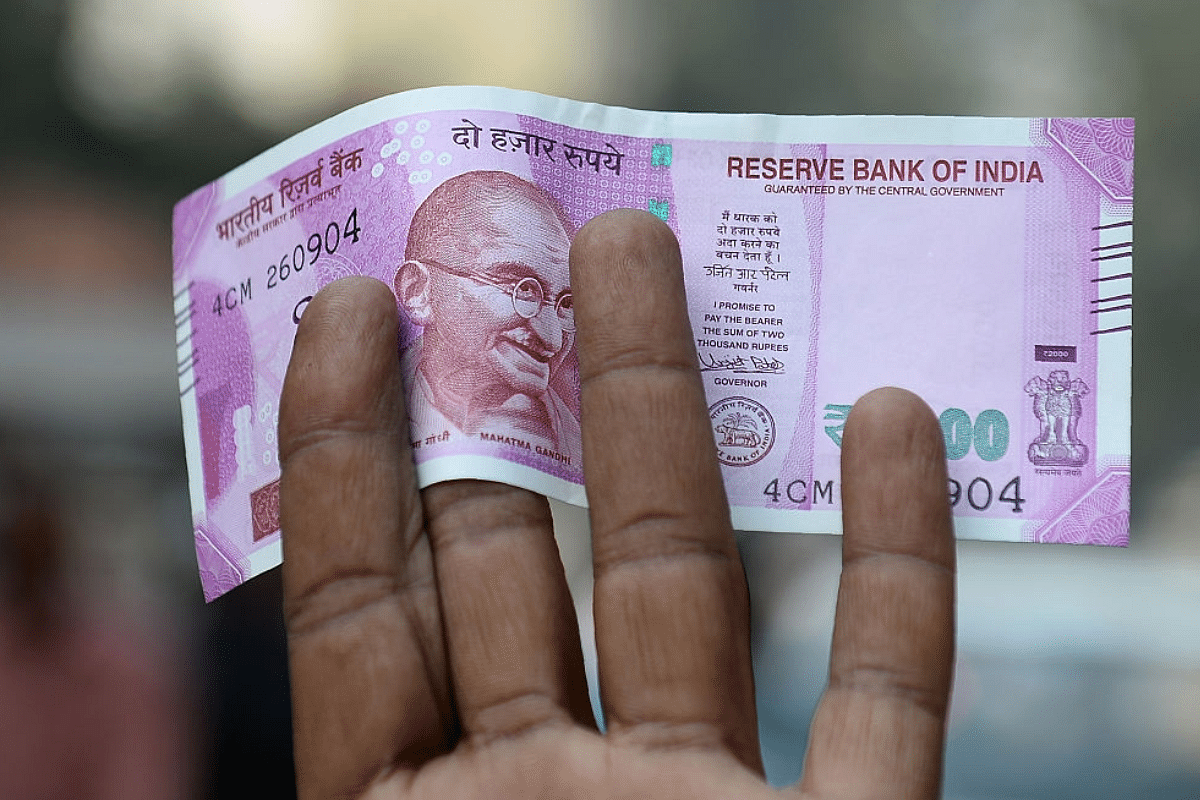News Brief
India's Currency In Circulation Drops By Rs 83,242 Crore As Rs 2,000 Notes Return To Banks

Rs 2,000 note (SAJJAD HUSSAIN/AFP/Getty Images) (representative picture)
The withdrawal of Rs 2,000 notes has led to a decrease in cash with the public by Rs 83,242 crore to Rs 32.88 lakh crore as of 2 June 2023, according to the latest data released by the Reserve Bank of India (RBI).
This is because a significant number of these notes have been returned to banks following the RBI's decision to withdraw them.
It is common for currency in circulation to increase during the crop sowing season due to withdrawals. However, the decision to withdraw Rs 2,000 notes has had the opposite effect.
The RBI had announced the decision to withdraw Rs 2,000 notes on 19 May .
The total value of these notes in circulation was Rs 3.62 lakh crore as of 31 March 2023. Since the announcement, around Rs 1.8 lakh crore, or 50 per cent of the Rs 2,000 banknotes in circulation, have been returned to the banking system, according to RBI Governor Shaktikanta Das on 8 June.
In contrast to the decrease in cash with the public, term deposits of banks have risen by Rs 2,68,262 crore during the fortnight ended 2 June 2023. This is a significant increase, especially considering that they had declined by Rs 3,998 crore in the previous fortnight ended May 19, 2023.
To determine the currency with the public, the cash with banks is subtracted from the total currency in circulation.
The term 'currency in circulation' refers to the physical currency or cash within a country that is used for conducting transactions.
According to Das, approximately 85 per cent of the Rs 2,000 notes are being deposited into bank accounts, which is in line with the RBI's expectations.
The central bank had previously stated that about 89 per cent of the Rs 2,000 denomination banknotes were issued before March 2017 and have now reached the end of their estimated lifespan of four to five years. The printing of these notes was discontinued in 2018-19.
The Reserve Bank of India has set a deadline of 30 September for the deposit or exchange of Rs 2,000 banknotes.
The decrease in the currency with the public can be attributed to the increase in the deposit of Rs 2,000 notes into banks, as per HDFC Bank Chief Economist Abheek Barua.
During the (crop) sowing season, there is typically a surge in cash withdrawals which results in an increase in currency in circulation. However, the deposit of Rs 2,000 bank notes has offset this effect.
Despite the deposit of a majority of Rs 2,000 notes in circulation, economist Dr.Soumya Kanti Ghosh does not expect a sharp decline in the currency with the public.
He believes that there might be a slow period followed by the sowing effect, which could take over and prevent a sharp decline in currency with the public.
State Bank of India Chairman, Dinesh Khara, announced on 29 May that his bank had received Rs 2,000 notes worth Rs 14,000 crore as deposits. This indicates that a significant number of Rs 2,000 notes have been deposited in banks.
Following the Reserve Bank of India's decision to withdraw Rs 2,000 notes from circulation, private lender Kotak Mahindra Bank garnered Rs 5,400 crore in deposits. This suggests that the withdrawal of Rs 2,000 notes has led to an increase in deposits in banks.
Bank of Maharashtra has reported that it received Rs 128 crore in fresh deposits due to the deposit of Rs 2000 notes. This state-run lender is just one of many that have seen an increase in deposits since the demonetisation of Rs 500 and Rs 1000 notes in November 2016.
Support Swarajya's 50 Ground Reports Project & Sponsor A Story
Every general election Swarajya does a 50 ground reports project.
Aimed only at serious readers and those who appreciate the nuances of political undercurrents, the project provides a sense of India's electoral landscape. As you know, these reports are produced after considerable investment of travel, time and effort on the ground.
This time too we've kicked off the project in style and have covered over 30 constituencies already. If you're someone who appreciates such work and have enjoyed our coverage please consider sponsoring a ground report for just Rs 2999 to Rs 19,999 - it goes a long way in helping us produce more quality reportage.
You can also back this project by becoming a subscriber for as little as Rs 999 - so do click on this links and choose a plan that suits you and back us.
Click below to contribute.
Latest